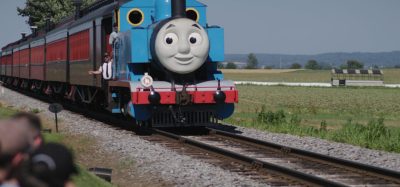European freight Corridors without borders
Posted: 3 December 2008 | | No comments yet
Facilitating and encouraging the use of goods trains in Europe is one of the objectives regularly repeated by the European Commission. The situation has never been as favourable to rail transport as it is today yet it is still struggling to outclass road transport in market shares. The Corridor concept has been designed to help it do so, but removing borders is not as simple as it sounds.
Facilitating and encouraging the use of goods trains in Europe is one of the objectives regularly repeated by the European Commission. The situation has never been as favourable to rail transport as it is today yet it is still struggling to outclass road transport in market shares. The Corridor concept has been designed to help it do so, but removing borders is not as simple as it sounds.
Facilitating and encouraging the use of goods trains in Europe is one of the objectives regularly repeated by the European Commission. The situation has never been as favourable to rail transport as it is today yet it is still struggling to outclass road transport in market shares. The Corridor concept has been designed to help it do so, but removing borders is not as simple as it sounds.
Given the increasing improvement in the efficiency of road transport, it is well-known that rail transport will have to increase its competitiveness and, more importantly, its quality. Its advantages have never been so obvious, with an increase in trade, soaring fuel prices and environmental concerns more than ever to the fore. It was in an effort to enhance these advantages that the idea of promoting a European rail network was launched, mainly for freight traffic and offering better quality of service in terms of time, reliability and capacity.
The 2001 White Paper on the European transport policy already provided for the establishment of ‘multimodal freight Corridors’ and, when it was reviewed in 2006, it still retained the project of a ‘rail freight network’. During that year, the European Commission stated, in one of its communications1, that there was a need for measures to encourage the implementation of the project, as this would be consistent with the process of establishing a single market.
Greater interoperability
Europe’s railways were built at a time when Europe was still the theatre of recurrent conflicts. This historical reminder is doubtless useful in order to understand what interoperability means for operators whose priority has, for many decades, been to prevent ill-intentioned neighbouring countries from sending trains onto their networks. This explains why the fluid circulation of goods trains in Europe is hindered by countless technical obstacles, some linked to infrastructures, others to operating standards. Gauges and electrical voltages are currently differences which are difficult to overcome. However, in the medium term, measures can be taken on the length of trains, axle load standards and tunnel gauges. Signalling systems will also have to change, but over the longer term. This was the point looked at by the European Commission in developing a new European control, command and signalling system called the European Rail Traffic Management System (ERTMS) and, to launch the changeover of national systems to ERTMS, the Commission decided to concentrate its grants on the routes with the highest levels of freight traffic to improve their potential. As a result of this, six priority European Corridors were defined in 2005:
- Rotterdam-Genoa (A)
- Naples-Stockholm (B)
- Antwerp-Basel-Lyon (C)
- Valencia-Lyon-Turin-Trieste- Budapest (D)
- Dresden-Prague-Brünn-Vienna-Budapest (E)
- Duisburg-Berlin-Warsaw (F)
One of the keys to the success of these international Corridors, and major national routes, is the presence of a port at the entry point.
Ensuring smooth traffic flow
Over the 2007-2013 period, the European Commission will spend €500 million on the deployment of ERTMS along Corridors. However, although essential, this investment is not sufficient for the ambitious concept of developing rail traffic. ERTMS cannot solve all the interoperability problems. It is important to also work on the conditions required to improve traffic flows. France is involved in two priority Corridors, C and D. The first of these runs for a distance of 1,840km and the second runs for 3,000km. They meet at Lyon and Ambérieu, providing interoperable links between the North and South of France. But more importantly, they set the French freight network fairly and squarely within the European rail space. Since 2005, the work carried out along these two routes by RFF has had a threefold objective:
- To coordinate the deployment of ERTMS
- To achieve a shared transnational view of traffic development as a set of necessary investments
- To find operational solutions to improve the running and quality of service of these Corridors, especially at the borders
In 2007, RFF joined its partners in setting up legal structures to run the Corridors through an executive committee and an EEIG (European Economic Interest Group) of infrastructure managers. Quite apart from technical interoperability, however, it is operating interoperability that is the most difficult to introduce. On the Lyon-Turin route, for example, dual-voltage interoperable locomotives are already running and there is no longer any need to change engines at the frontier. In theory, therefore, there is no technical obstacle to fluid traffic flow. However, the operating procedures have remained unchanged. The train still stops in Modane to change driver and swap operating documents.
The border problem
International freight suffers a downturn in performance when it reaches the frontiers, as is obvious from what happens on the Lyon-Turin route. At the border, rail traffic reached a volume of 11 million tonnes in 1997 then declined regularly to 6.5 million tonnes in 2007. The inadequacy of services at Modane, partly because of the work being undertaken there, has led to traffic from the Benelux countries and the United Kingdom being diverted along the right bank of the Rhine. In addition to the work in progress to update the gauge on certain sections, RFF and its Italian colleague RFI have joined forces with rail companies and decided to take action because they are convinced of the commercial potential of this route. The truth is that more than €300 million have been invested since the early 2000’s along this historic route and the two infrastructure managers have therefore looked into operational measures which could, without additional heavy investment, help to improve the quantity and quality of the services offered in the short term. They submitted their proposals to the European Coordinator, Lawrence Jan Brinkhorst, and he will shortly be submitting a draft action plan to the French and Italian Ministers of Transport. RFF and RFI agreed on two principles – single operational responsibility and a more fluid traffic flow. This means considering Modane as a transfer station and gradually removing the obstacles to the continuous, unbroken circulation of trains. The measures recommended were based on feedback from grass roots level. It will undoubtedly take a lot of effort to change traffic regulations, maximise the shunting system, give added permanence to real-time dialogue between Turin and Chambéry, standardise the composition of trains, braking and speed regulations. Political support will also undoubtedly be necessary to adapt the infrastructure, mainly by increasing the length of the transfer lines to above 500 metres and train tonnage to 1,400 or even 1,600 tonnes.
Meanwhile, on both sides of the border, action has already started, with the appointment of a single manager for international train paths. In addition to the investments in ERTMS and infrastructure, and the work carried out jointly by infrastructure managers on operating regulations at frontiers, this job constitutes the third structuring component for European rail freight Corridors and it is the job of RailNetEurope (RNE). Working on these three elements is the only way to success.
During the French Presidency of the European Union, Réseau Ferré de France and the French Ministry for Ecology, Energy, Sustainable Development and Town and Country Planning organised the rail event: ‘European Rail Forum: Freight Without Frontiers’. This conference took place in Paris on 29 October 2008 in Paris (UIC).
You will also find relevant information on the website of the French Presidency of the European Union: www.ue2008.fr
Reference
- “Communication on freight transport logistics in Europe – the key to sustainable mobility” – June 2006







